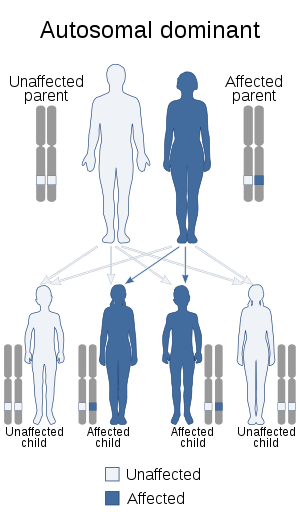Léri–Weill dyschondrosteosis
Léri–Weill dyschondrosteosis or LWD is a rare pseudoautosomal dominant genetic disorder which results in dwarfism with short forearms and legs (mesomelic dwarfism) and a bayonet-like deformity of the forearms (Madelung's deformity).[1]
| Léri–Weill dyschondrosteosis | |
|---|---|
 | |
| Léri–Weill dyschondrosteosis is inherited in an autosomal dominant manner | |
| Specialty | Medical genetics |
Causes
It is caused by mutations in the short-stature homeobox gene found in the pseudoautosomal region PAR1 of the X and Y chromosomes, at band Xp22.33 or Yp11.32.[2]
SHOX gene deletions have been identified as the major cause of Leri–Weill syndrome.[3]
Leri–Weill dyschondrosteosis is characterized by mesomelic short stature, with bowing of the radius more so than the ulna in the forearms and bowing of the tibia while sparing the fibula.
Diagnosis
Diagnosis is made following genetic blood testing.
Treatment
History
LWD was first described in 1929 by André Léri and Jean A. Weill.[4][5]
References
- Benito-Sanz S, Thomas NS, Huber C, et al. (October 2005). "A Novel Class of Pseudoautosomal Region 1 Deletions Downstream of SHOX Is Associated with Léri–Weill Dyschondrosteosis". Am. J. Hum. Genet. 77 (4): 533–44. doi:10.1086/449313. PMC 1275603. PMID 16175500.
- Gatta V, Antonucci I, Morizio E, et al. (2007). "Identification and characterization of different SHOX gene deletions in patients with Leri–Weill dyschondrosteosys by MLPA assay". J. Hum. Genet. 52 (1): 21–7. doi:10.1007/s10038-006-0074-5. PMID 17091221.
- Fukami M, Dateki S, Kato F, et al. (2008). "Identification and characterization of cryptic SHOX intragenic deletions in three Japanese patients with Léri–Weill dyschondrosteosis". J. Hum. Genet. 53 (5): 454–9. doi:10.1007/s10038-008-0269-z. PMID 18322641.
- synd/1662 at Who Named It?
- Léri A, Weill JA (1929). "Une affection congénitale et symétrique du développement osseux. La dyschondrostéose". Bulletins et Memoires de la Société Medicale des Hôpitaux de Paris. 53: 1491–1494.
External links
| Classification | |
|---|---|
| External resources |